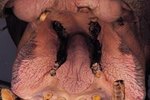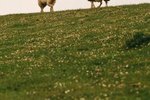
Despite being different species, horses and cows have some commonalities: they are mammals, have hooves, are herbivores and have 24 molars each, correctly categorized as 12 molars and 12 pre-molars. Their shared herbivore characteristic is the one trait that sheds light on why they need so many molars, and why they're able to share their outdoor living spaces.
Cow Teeth
Cows have fewer teeth overall than many other mammals but the same number as humans: 32. The 24 molars are in the back of the mouth, evenly divided among the top and bottom jaws, six to a side. The other dental trait that's unusual is that cows have no front top teeth. They have 6 incisors and 2 canine teeth, but they are all on the bottom. Instead of top teeth in front, cows have a rough, leathery surface covering their top gums called a dental pad. If you feel along the top of your cow’s mouth, you might mistake the roughness of the dental pad for teeth.
Horse Teeth
Horses have more teeth than cows and, oddly enough, the number often varies among horses. Your horse will have at least 36 teeth at about age 5, but could have as many as 44. Like a cow, his 24 molars are at the back of the mouth, equally divided among each side on the top and bottom. But unlike the cow, your horse has 12 incisors in the front -- six on top and six on the bottom.
Some horses have four or five canine teeth between the molars and incisors, but they are more common in males than females. Some females have canine teeth that will never come through completely, which is not a cause for worry. Your horse may develop wolf teeth by the time he's 1 year old, but these should be removed before he has a bit in his mouth.
How Cows Eat
The dental pad and teeth combined helps your cows get large quantities of forage -- grass or hay. They grab the grass with their tongues and pinch it together between the incisors and dental pad. This helps them get more grass at once, but without the top teeth they can’t graze low to the ground. This means they need a larger pasture area than more efficient grazers with top incisors. The all-important molars grind the forage in a side-to-side chewing motion, which breaks down the grass into very small pieces. Cows eat large quantities and swallow, but it gets pushed back up through the esophagus for more chewing later. Animals that do this are called ruminants.
How Horses Eat
Unlike their bovid counterparts, horses are able to shear the pasture grass down very close to the ground using their top and bottom incisors, without pulling up the roots. Their tongues push food back to the molars where, like cows, they grind their food in a side-to-side motion. Horses are not ruminants so they must thoroughly chew their food before swallowing for safe digestion. You can gauge the efficiency of your horse’s eating and digestion by checking his feces; if you see hay particles that are more than 3/8-inch long, he may have problems with his molars that prevent proper grinding, or mastication.
References
- American Association of Equine Practitioners: Equine Dental Care: What Every Horse Owner Should Know
- U.S. Food & Drug Administration: How Cows Eat Grass – Exploring Cow Digestion
- Virginia Tech, Virginia Cooperative Extension: Nutrition and Feeding of the Cow-Calf Herd: Digestive System of the Cow
- Princeton University: Horse Teeth
- Natural Horse Magazine: Your Horse Needs Proper Dental Care
Resources
Photo Credits
-
Jupiterimages/Photos.com/Getty Images
Writer Bio
Based in Central Texas, Karen S. Johnson is a marketing professional with more than 30 years' experience and specializes in business and equestrian topics. Her articles have appeared in several trade and business publications such as the Houston Chronicle. Johnson also co-authored a series of communications publications for the U.S. Agency for International Development. She holds a Bachelor of Science in speech from UT-Austin.




